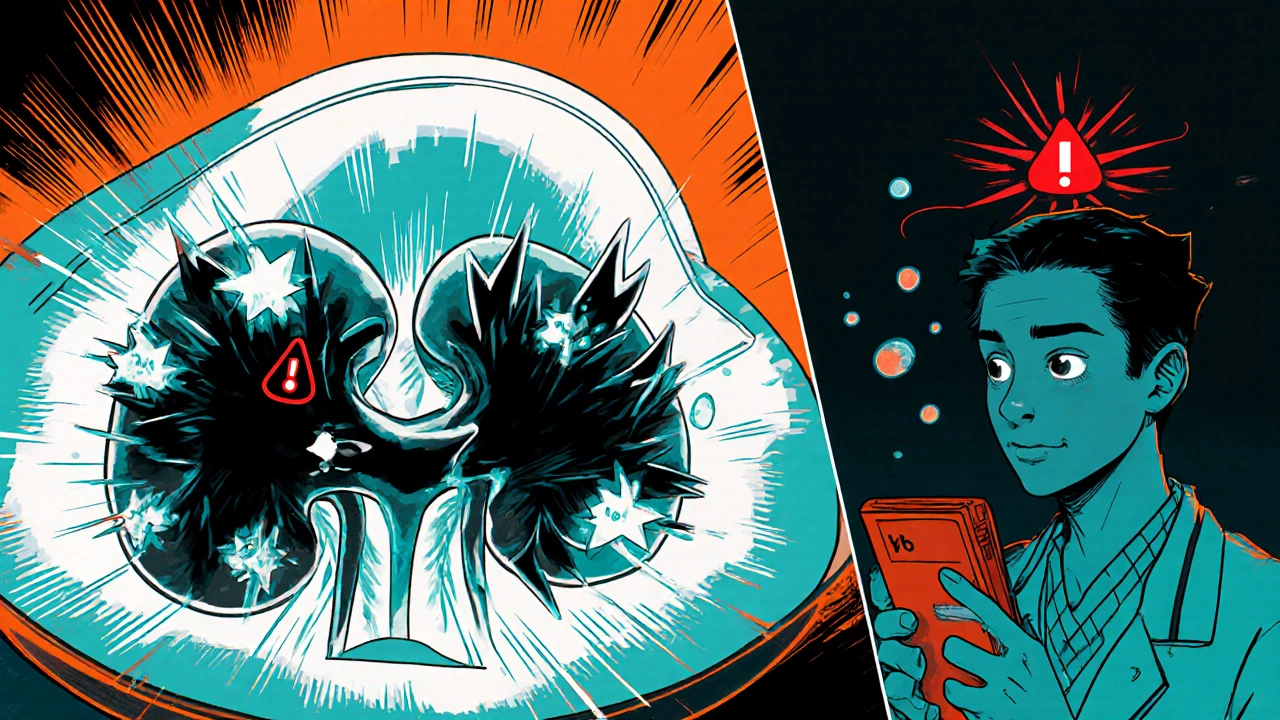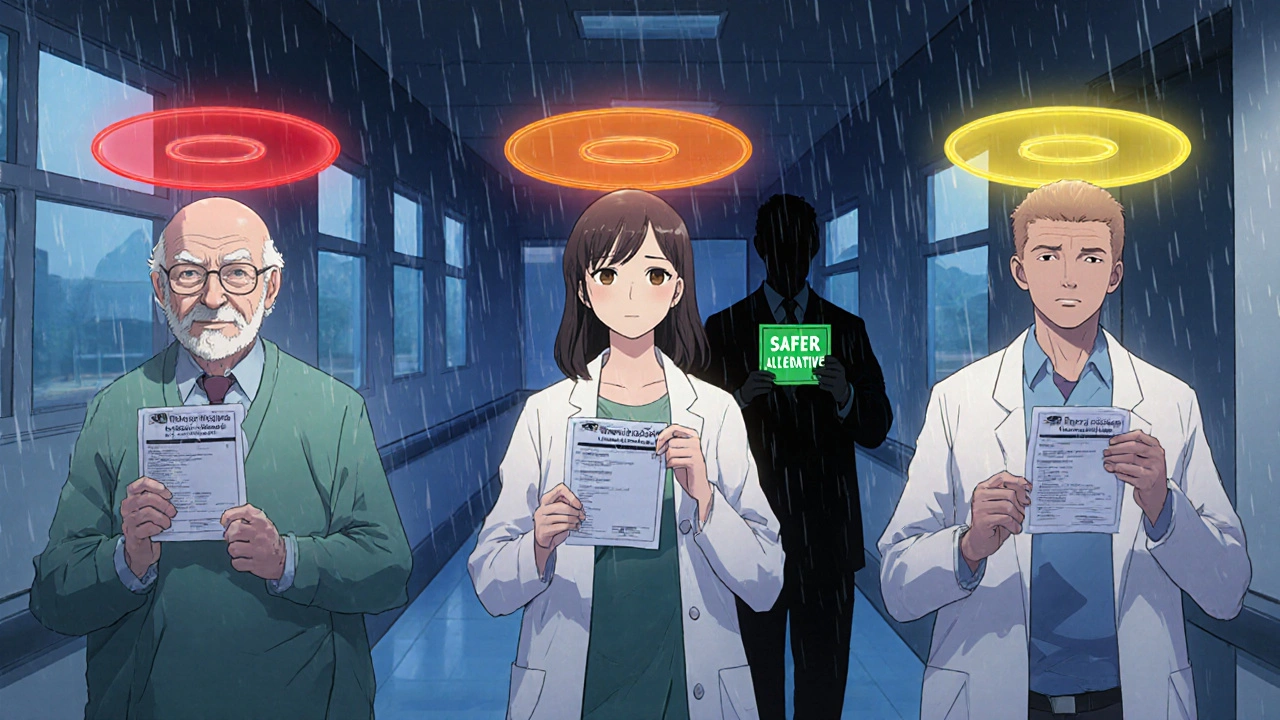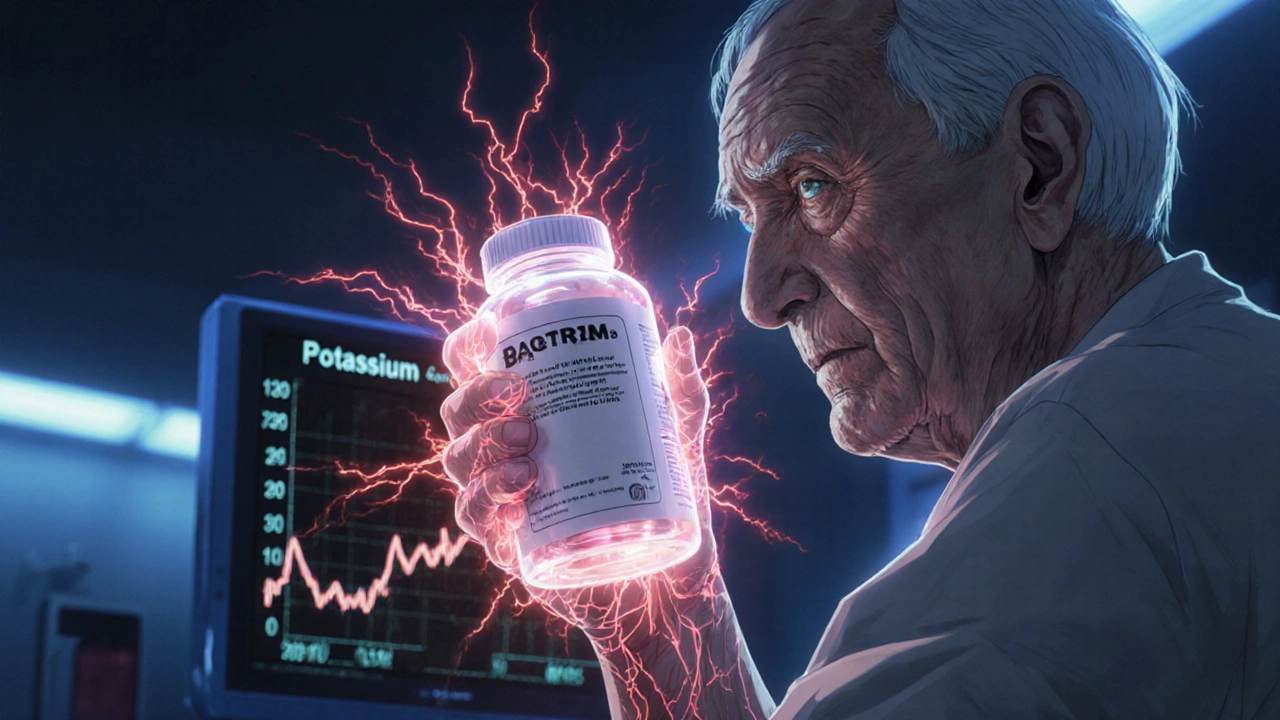Trimethoprim Hyperkalemia Risk Calculator
Assess Your Hyperkalemia Risk
Hyperkalemia Risk Assessment
When you take an antibiotic like Bactrim or Septra for a urinary tract infection or sinus infection, you’re probably not thinking about your potassium levels. But for some people, this common drug can cause a dangerous spike in potassium - one that can lead to heart rhythm problems, muscle weakness, or even cardiac arrest. The culprit isn’t sulfamethoxazole. It’s trimethoprim.
How Trimethoprim Raises Potassium Levels
Trimethoprim doesn’t work like most antibiotics when it comes to potassium. Instead of just killing bacteria, it mimics a kidney drug called amiloride. Both block sodium channels in the part of the kidney that controls how much potassium gets flushed out in urine. When these channels are blocked, sodium doesn’t get reabsorbed properly. And without enough sodium movement, the electrical signal that pushes potassium out of the blood and into the urine gets weak or stops entirely.
This isn’t a slow, creeping issue. In many cases, potassium levels start rising within 48 hours of starting trimethoprim. A 2012 case study showed patients’ potassium levels jumped by 0.5 to 1.5 mmol/L in just two to three days. That might not sound like much - but normal potassium is between 3.5 and 5.0 mmol/L. A rise to 6.0 or higher is life-threatening.
Why does this happen so fast? Because trimethoprim concentrates in the kidneys. Even though blood levels are low, the drug builds up in kidney tubules at 10 to 50 times the concentration found in the bloodstream. That’s why it has such a strong effect on potassium - even at standard doses.
Who’s at the Highest Risk?
Not everyone who takes trimethoprim will get high potassium. But certain people are at much higher risk:
- People over 65
- Those with chronic kidney disease (eGFR below 60)
- Patients taking ACE inhibitors (like lisinopril) or ARBs (like losartan)
- People already on potassium-sparing diuretics (like spironolactone)
- Those with diabetes
A 2014 study in JAMA Internal Medicine found that older adults on ACE inhibitors or ARBs who took trimethoprim had a 6.7 times higher risk of being hospitalized for hyperkalemia than those who took amoxicillin. That’s not a small increase - it’s a massive red flag.
The numbers get worse when multiple risk factors stack up. One 2020 study found that patients with diabetes, stage 3 or higher kidney disease, and an ACE inhibitor or ARB had a 32.1% chance of developing dangerous hyperkalemia after taking trimethoprim. Compare that to just 4.3% in similar patients who took a different antibiotic.
Even people with normal kidney function aren’t completely safe. A 2023 case report described an 80-year-old woman with normal creatinine levels who developed a potassium level of 7.8 mmol/L - enough to trigger cardiac arrest - just three days after starting low-dose trimethoprim for pneumonia prevention.
How Common Is This Problem?
It’s more common than most doctors realize. Studies show:
- 8.4% of patients on standard-dose trimethoprim develop hyperkalemia
- Up to 17.6% of those with kidney impairment
- 23.7% of patients on high-dose trimethoprim (used for Pneumocystis pneumonia)
And the consequences are serious. Between 2010 and 2020, the FDA’s adverse event database recorded 1,247 cases of trimethoprim-linked hyperkalemia - including 43 deaths. Nearly 70% of those fatal cases were in people over 65.
Yet, a 2023 survey found only 41.7% of primary care doctors routinely check potassium levels before prescribing trimethoprim to patients on blood pressure meds. Emergency medicine doctors? Just 32.4%.

Why Doctors Still Prescribe It
Given the risks, why is trimethoprim still used so often? Because for certain infections, it’s still one of the best options.
It’s the go-to drug for preventing Pneumocystis pneumonia in people with HIV or after organ transplants. It’s also effective for urinary tract infections, especially when other antibiotics fail or aren’t available. In some cases, the benefits outweigh the risks - if you’re monitoring closely.
Experts like Dr. Michael Stevens point out that in immunocompromised patients, avoiding trimethoprim could mean risking a deadly infection. The key isn’t to never use it - it’s to use it wisely.
What You Should Do If You’re Taking Trimethoprim
If you’re on trimethoprim - especially if you’re over 65 or take blood pressure meds - here’s what you need to know:
- Ask your doctor to check your potassium before you start. A simple blood test can set a baseline.
- Get tested again in 48 to 72 hours. That’s when potassium levels typically peak.
- Watch for symptoms. Muscle weakness, fatigue, irregular heartbeat, nausea, or tingling in hands or feet could signal high potassium.
- Don’t skip follow-ups. If you’re on trimethoprim for more than a week, ask for weekly potassium checks.
- Know your alternatives. For urinary tract infections, nitrofurantoin is just as effective and doesn’t raise potassium. For other infections, amoxicillin, cephalexin, or doxycycline may be safer.
Many hospitals now have electronic alerts that block trimethoprim prescriptions if the patient is on an ACE inhibitor or ARB - unless a potassium test has been done. But outside of big hospitals, these systems aren’t always in place.

What to Do If Your Potassium Is Too High
If your potassium level hits 5.5 mmol/L or higher, your doctor should stop trimethoprim immediately. Levels above 6.0 mmol/L are a medical emergency.
Emergency treatment may include:
- Calcium gluconate - to protect the heart
- Insulin and glucose - to shift potassium into cells
- Albuterol inhaler - to help move potassium into cells
- Dialysis - if levels are extremely high or kidney function is poor
Most patients recover fully if treated quickly. But delays can be fatal.
What’s Being Done to Fix This
There’s growing awareness. In 2019, the FDA added hyperkalemia to trimethoprim’s boxed warning - the strongest safety alert they issue. But many experts say that’s not enough.
A 2023 study showed that when pharmacists used real-time alerts to suggest safer alternatives, trimethoprim prescribing in high-risk patients dropped by 63%. Another study created a risk score called the TMP-HyperK Score, which uses age, baseline potassium, kidney function, and medication use to predict risk with over 88% accuracy.
The Institute for Healthcare Improvement now lists trimethoprim-induced hyperkalemia as a top patient safety priority through 2026. They estimate that better monitoring could prevent 12,000 to 15,000 hospitalizations every year in the U.S. alone.
The Bottom Line
Trimethoprim isn’t a dangerous drug for everyone. But for a large group of people - especially older adults and those on blood pressure meds - it’s a ticking time bomb. The risk isn’t theoretical. It’s well-documented, predictable, and preventable.
If you’re prescribed Bactrim or Septra, ask: “Have you checked my potassium? Is this the safest option for me?” If you’re on an ACE inhibitor or ARB, there are almost always safer antibiotics available. Don’t assume your doctor knows the risk - many don’t. Your life could depend on asking the question.






12 Comments
steffi walsh
November 18, 2025Wow this is such an eye-opener 😊 I had no idea trimethoprim could mess with potassium like that. My grandma was on Bactrim last year and kept saying she felt "weirdly tired" - now I’m gonna ask her doc if they checked her levels. So glad someone put this out there!
Riohlo (Or Rio) Marie
November 19, 2025How quaint. Another medically literate layperson discovers that pharmaceuticals aren’t benign candy. The fact that this isn’t standard protocol before prescribing trimethoprim speaks volumes about the abysmal state of primary care education. I mean, really - we’ve known since the 90s that trimethoprim acts as a potassium-sparing diuretic. It’s not rocket science. It’s renal physiology 101. And yet, here we are, watching elderly patients become cardiac time bombs because no one bothered to check a basic electrolyte panel. The system is broken. And no, I don’t want to hear about "antibiotic stewardship" - stewardship without safety is just negligence dressed in white coats.
Conor McNamara
November 20, 2025theyre not telling you the whole truth about this... i read somewhere that big pharma knows trimethoprim causes hyperkalemia but they keep selling it because it makes more money than the safer options. they dont want you to know about nitrofurantoin because its cheap and generic and they cant patent it. also the fda is owned by pfizer. i saw a video on youtube where a guy in a lab coat said it. dont trust your doctor. theyre paid to keep you sick.
Leilani O'Neill
November 20, 2025Irresponsible. Absolute negligence. America lets untrained GPs hand out antibiotics like candy while people die from preventable electrolyte disasters. Meanwhile, in Europe, we have mandatory potassium screening protocols for any patient over 50 on antihypertensives. We don’t wait for someone to code in the ER before we act. This is why your healthcare system is a laughingstock. You don’t need a PhD to understand that blocking renal sodium channels = potassium retention. It’s basic. And yet, here we are. Shameful.
Yash Nair
November 20, 2025my cousin in delhi got prescribed bactrim for a uti and got real sick and they said his k+ was 7.2 he was in icu for 3 days. why dont docs here check this? they just give the pill and say "take it twice a day". we need to stop this madness. my aunty died from this in 2021 and no one said anything
Kristina Williams
November 21, 2025so wait… so if you’re on blood pressure meds and you take this antibiotic… your heart could just stop? like… for real? that’s wild. i mean i knew antibiotics were strong but i thought they just killed bacteria. not like… sabotage your kidneys? this is like a hidden bomb. i’m never taking bactrim again. i’m going to ask for amoxicillin. my mom’s on lisinopril and she just got a prescription for this. i’m calling her right now.
Shilpi Tiwari
November 23, 2025the pharmacokinetics here are fascinating - trimethoprim’s tubular concentration gradient creates a localized ENaC antagonism that’s functionally indistinguishable from amiloride, despite negligible systemic exposure. this explains the rapid onset and disproportionate effect on potassium. the real clinical challenge is that creatinine remains normal while GFR declines subtly - so eGFR is critical. we need to integrate risk stratification tools like the TMP-HyperK Score into EHRs. without algorithmic prompts, human oversight fails. this isn’t just about education - it’s about system design.
Christine Eslinger
November 24, 2025This is one of those topics that should be taught in every med school, but somehow slips through the cracks. I’ve seen it too many times - the elderly patient on lisinopril, no history of kidney disease, gets Bactrim for a "sinus infection," and three days later, they’re in the ER with peaked T-waves. It’s heartbreaking. But here’s the good news: it’s preventable. A simple potassium test before prescribing - and another 72 hours in - catches 95% of these cases. Doctors aren’t bad people. They’re just overwhelmed. We need better tools, not blame. And patients? You’re not being paranoid if you ask, "Have you checked my potassium?" You’re being smart.
Brenda Kuter
November 25, 2025OMG I JUST REALIZED MY DAD TOOK THIS LAST MONTH AND HE’S BEEN SO TIRED AND HIS HANDS TINGLE!! I THOUGHT IT WAS JUST AGING!! I’M CALLING HIS DOCTOR RIGHT NOW AND DEMANDING A BLOOD TEST!! THIS COULD’VE KILLED HIM!! I’M SO ANGRY!! WHY DOESN’T THE PHARMACY WARN YOU?! WHY DOESN’T THE SCRIPT SAY "DANGER"?! I’M GOING TO POST THIS EVERYWHERE!!
Sarah Frey
November 26, 2025Thank you for sharing this with such clarity and care. This is the kind of information that doesn’t get enough airtime - not because it’s not important, but because it’s uncomfortable. The truth is, many of us take antibiotics without a second thought. But when you’re over 65, on blood pressure meds, or diabetic, this isn’t just a "side effect" - it’s a silent threat. The fact that only 32% of ER docs check potassium before prescribing? That’s not a gap in knowledge. That’s a gap in systems. We need mandatory alerts. We need pharmacist interventions. We need to stop treating patients like statistics. You’ve given us a roadmap. Let’s use it.
Katelyn Sykes
November 27, 2025my nurse practitioner just switched me from bactrim to nitrofurantoin after i asked about potassium and she looked at me like i was a genius. honestly i just googled it after reading this post. dont be afraid to ask. its your body. and nitrofurantoin works just as well for utis. also dont eat bananas while on this stuff. just saying. 😅
Gabe Solack
November 28, 2025Just saved my mom’s life with this info 🙏 She’s 72, on losartan, and got prescribed Bactrim last week. I printed this out and handed it to her doctor. He said he’d never seen it happen but agreed to check her K+ stat. It was 5.8. They stopped the antibiotic, gave her insulin/glucose, and she’s fine now. I’m sending this to every family group chat. We need to stop assuming doctors know everything. Sometimes they don’t - and that’s okay. What matters is that we ask.